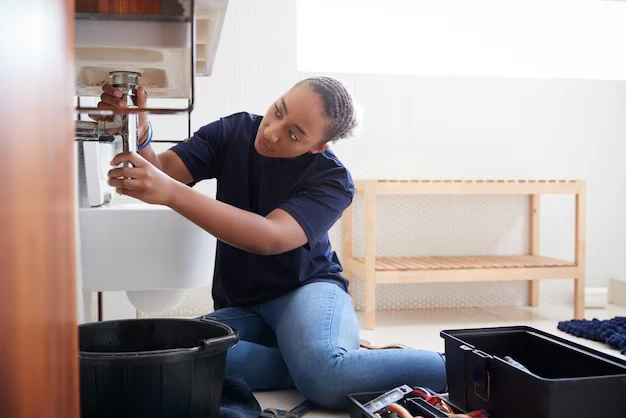As homeowners, we all want to save money when possible. But sometimes plumbing problems arise that require costly repairs, and we don’t always have the budget to cover them. The good news is, there are some DIY plumbing hacks that you can use to save money and fix your plumbing issues without breaking the bank.
From clogged drains and leaky pipes to running toilets and blocked sewers, these DIY plumbing hacks will help you fix common plumbing issues quickly and easily. You’ll save not only money, but also time and energy.
In this blog post, we’ll discuss five DIY plumbing hacks that can keep your plumbing problems under control and save you money. We’ll detail how each hack works, which tools and materials you need, and the time and cost savings associated.
1. Leaky Faucet
A leaky faucet is not only annoying but it can also lead to an increase in your water bill. Addressing the issue as soon as possible is important before it becomes a bigger headache. If you’re looking to save money, consider fixing the problem yourself. In this article, we’ll discuss DIY plumbing hacks to help you fix a leaky faucet.
The first step in fixing a leaky faucet is to identify the type of fixture. A slow drip is often an indication of a worn gasket or washer. You can try replacing it yourself, but make sure you purchase the right size washer that fits the tap. You can find these at your local hardware store.
Before you start any repairs, turning off the water supply to the faucet is important. You can close the shut-off valves under the washbasins or sinks. Turning off the water stops the faucet from dripping and allows you to work on the fixture without causing any further damage.
Once you’ve turned off the water supply, you can disassemble the faucet. It’s important to keep track of the parts you remove so that you can easily reassemble them later. A good tip is to lay out the parts in the order that you remove them.
2. Clogged Drain
DIY plumbing hacks can come in handy when you are faced with the pesky problem of a clogged drain. A slow-draining sink or shower can be frustrating, and calling a professional plumber can be expensive. Luckily, some easy and affordable DIY plumbing hacks can save you money.
First, check if the blockage is right below the plug. If not, you can begin by pouring extremely hot water into the drain. This can help to loosen up any debris that may be causing the clog. Next, sprinkle a quarter cup of baking soda into the drain. Baking soda is a natural cleaner that can help break down any stubborn clogs.
Now, mix vinegar with hot water and pour it down the sink. Combining vinegar and baking soda will create a fizzing reaction that helps break down any remaining debris. Leave the mixture for 10 minutes before rinsing the drain with hot water. This should help to wash down any loose clogs inside.
If the clog persists, you may need to repeat the process a few times or even try using a plunger. However, this simple DIY plumbing hack using baking soda, vinegar, and hot water can effectively unclog a drain.
3. Running Toilet
To determine the cause of your running toilet, lift the tank lid and observe the parts inside. If the water level is too high, adjust the float on the fill valve to lower it. If the flapper is visibly damaged or doesn’t seal properly, it’s time to replace it. You can find replacement flappers at most hardware stores or online. Finally, if the flush valve leaks, you must replace it. This may require more advanced plumbing knowledge, so if you’re uncomfortable with this step, consider calling a professional plumber (For Norway, visit Rørleggeren i Oslo).
Now that you know the common causes of a running toilet and how to fix them, let’s dive into some DIY plumbing hacks that can save you money. These tips are not only budget-friendly, but they’re also eco-friendly as they reduce water waste.
First, place a brick or a plastic bottle filled with water in your toilet tank. This will displace some water, so your toilet uses less water with each flush. Just make sure not to disrupt any of the other parts in the tank.
4. Low water pressure
One of the first things you can try is removing the aerator from the faucet and cleaning out any debris that may have built up inside. This is often the cause of low water pressure, as minerals such as calcium can accumulate over time and block water flow. Simply unscrew the aerator from the faucet and use a toothbrush or small brush to clean out any buildup. Then, reattach the aerator and test the water pressure again.
If cleaning the aerator doesn’t solve the problem, there may be a water leak somewhere else inside your home. This can be caused by broken or corroded pipes, which can be difficult to identify and repair without professional help. However, there are a few things you can check for before calling in a plumber.
First, check the water meter to see if it’s still running even when all the faucets in your home are turned off. If it is, this is a sign that you have a water leak somewhere and will need to locate it. You can also check for wet spots or puddles around your home’s foundation or yard, which can signify a broken pipe.
If you discover a water leak, you will need to replace any damaged pipelines to fix the low water pressure issue. While this may sound daunting, many online tutorials and guides can help you tackle the project yourself, saving you money on professional plumbing services.
6. Leaking pipes
One of the most common causes of leaking pipes is corrosion. Pipes inside the walls start leaking at the joints or corroded areas. If you notice any signs of rust or lime deposits on the pipes, it’s time to take action. These deposits can weaken the pipes and make them more prone to leakage. You can prevent leaking in the pipes by checking them for rust or lime deposits.
If you notice rust or lime deposits, try cleaning the affected area with a wire brush. This can help remove the deposits and prevent further corrosion. You can also use a chemical rust remover to remove the rust.
If you’re dealing with a more serious leak, you may need to replace the entire pipe. This is a job best left to the professionals, but there are some things you can do to minimize the damage. First, turn off the water supply to the affected area. Then, use a bucket or towel to catch any water that may be leaking.
Wrapping up
Above 5 DIY plumbing hacks are great ways to save money and tackle common plumbing issues without professional help. By following these simple tips and tricks, you can easily fix clogged drains, leaky pipes, running toilets, and blocked sewers. Not only will you save money, but you’ll also develop some plumbing skills along the way. Remember these hacks the next time you encounter a plumbing issue, and you’ll be well on your way to becoming a DIY plumbing expert.












